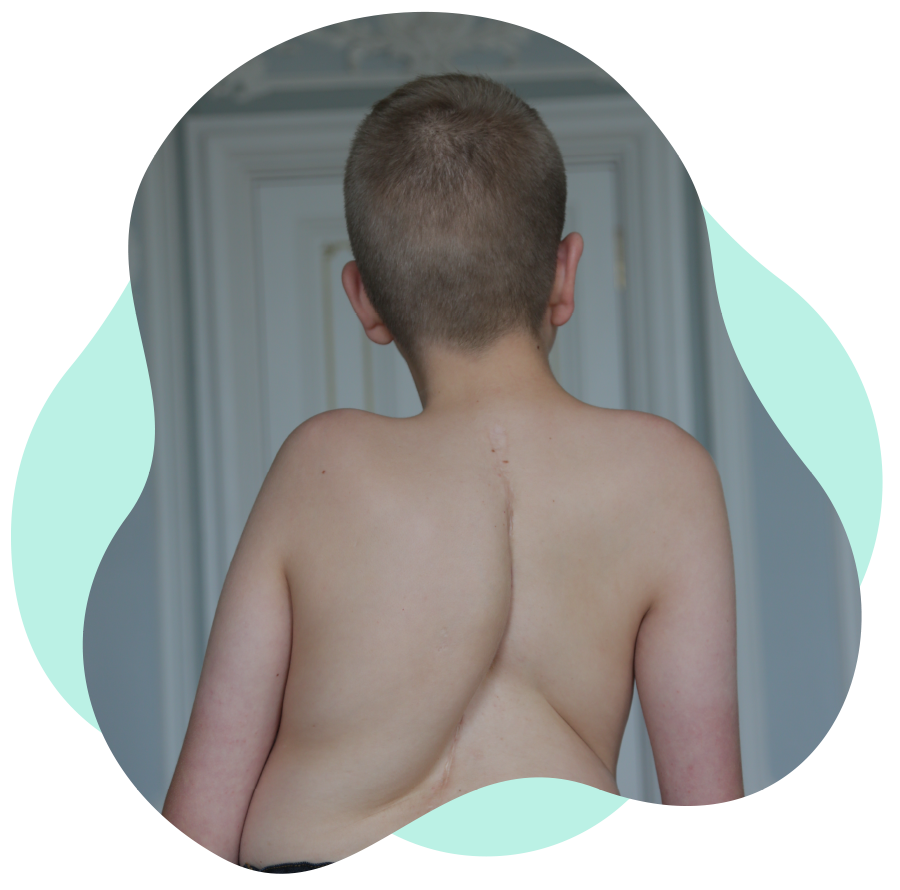What is Neuromuscular scoliosis
Neuromuscular scoliosis is a curvature of the spine caused by either a neurological, meaning disorders relating to a person’s nervous system including the brain, spinal cord and nerves, or a muscular condition. Examples of neuromuscular scoliosis are muscular dystrophy, spinal muscular atrophy, spinal cord trauma, cerebral palsy and spina bifida, however, not all people with these types of neurological condition will develop scoliosis.
What causes neuromuscular scoliosis?
Neurological conditions happen when there is damage to the brain or nerves caused by an illness or injury and can affect the muscle-nerve pathways of the body from the brain down to the spinal cord. Neuromuscular scoliosis develops as a result of these primary neurological or muscular conditions.
Many of the conditions that can cause neuromuscular scoliosis to develop stop the muscles from supporting the spine correctly, causing curves in the spine. Examples of such neuromuscular conditions, such as Duchenne muscular dystrophy or spinal muscular atrophy, mean that patients can develop scoliosis or kyphosis, which is an abnormal rounding of the spine, or both. As the person with a neuromuscular condition grows and their trunk muscles get weaker, the spine can gradually begin to collapse, which can create a long C-shaped ‘collapsing’ scoliosis. In children and teenagers these curves continue to get bigger during growth spurts and during puberty.
For children who use a wheelchair, progressive curves can make it difficult for them to sit comfortably. Large curves (measuring 80o or above) in the upper or middle parts of the spine may cause lung problems.
How will my neuromuscular scoliosis be diagnosed?
Your existing healthcare professionals should refer you a scoliosis specialist if they concerns about your spine, but you can also seek advice from our helpline on 020 8964 1166 or e-mail: info@ssr.org.uk.
All patients with neuromuscular scoliosis should be seen by a scoliosis specialist and children should be monitored by specialist doctors from a young age. This monitoring is essential to make sure that curvatures do not get too big.
X-rays of the spine will be taken to measure the size of the curve, this is called the Cobb angle, which is the name given to the exact degree of the curve.
MRI scans of the brain and the spine may be needed to rule out any other problems.
The treatment of neuromuscular scoliosis will be tailored to the needs of each individual patient as they will need a number of specialists involved in their care.
What treatment will I receive?
Scoliosis can make walking more difficult meaning that wheelchair users can find that their stability or comfort whilst sitting in their chair is affected. Part of your treatment will be to work with the specialists to find solutions to such concerns.
Bracing
Bracing might be used to provide support for the patient’s trunk (central part of the body) whilst also helping to slow the rate at which the curve worsens. The brace is fitted to the shape of the body and adjustments and aids, such as inserts into wheelchairs, may help with the positioning and comfort. The brace is used to prevent the curve from progressing but will not correct the scoliosis.
Surgery
Surgery is usually only offered to patients who have a progressive (growing) curve that interferes with the normal function of their body, affects breathing ability, causes pain, or is likely to cause difficulties in the years ahead. Surgery may also be offered to patients with curves larger than 50 degrees who have a tilted pelvis (pelvic asymmetry) as well as a large spinal curve. In these cases the spine and the pelvis will be operated on to correct the asymmetry, but the main aim is to stop the curve from getting worse. Although many patients who need and have this surgery are severely disabled, the treatment can usually help them live fulfilling and productive lives.
A key issue for patients, families and their doctors is whether surgery is the best choice. Surgery would aim to help the patient retain the ability to sit comfortably. This could help to maintain or improve the patient’s quality of life and the normal and proper ‘function’ of their body-parts and organs.
For some children and adults with cognitive or sensory impairment decisions about whether to progress with surgery can be difficult. Parents of children with cognitive or sensory impairments can struggle with the fact that they can’t explain to their child why they are having surgery or make clear the pain that goes along with this operation. Talking with other families who have been through this decision process is very helpful. SAUK can put families in touch with other members who have first-hand experience of neuromuscular scoliosis and the available treatments. In the end, it will often be down to the parents to make this difficult decision for their child, but you can also seek advice from our helpline on 020 8964 1166 or e-mail: info@ssr.org.uk.
How will neuromuscular scoliosis affect my life?
Scoliosis is common in neuromuscular conditions and often occurs when a child is young. It is important to spot scoliosis early and children with neuromuscular conditions need to be checked every year for any problems with the spine. Treatments can help improve the quality of life of those living with neuromuscular conditions and the resulting scoliosis, and your healthcare team and scoliosis specialists will work together to care for you or your child.
Definitions
Cognitive – Mental activities such as thinking, understanding, learning, and remembering
Function – The special, normal, or proper action of any body part or organ
If you need help or advice please call our Helpline on 020 8964 1166 or e-mail: info@ssr.org.uk.




